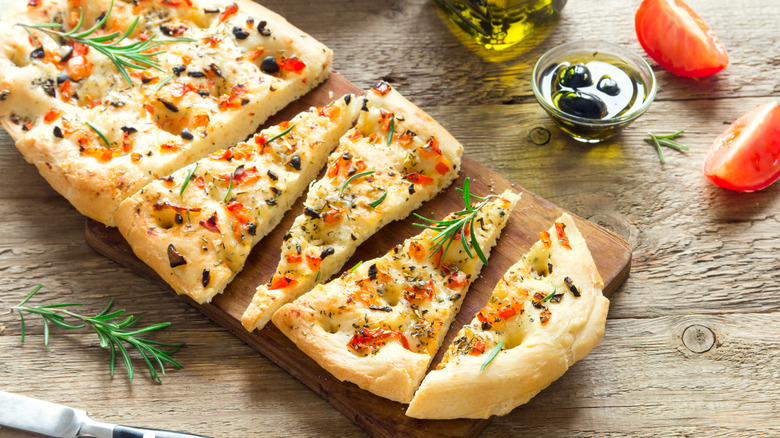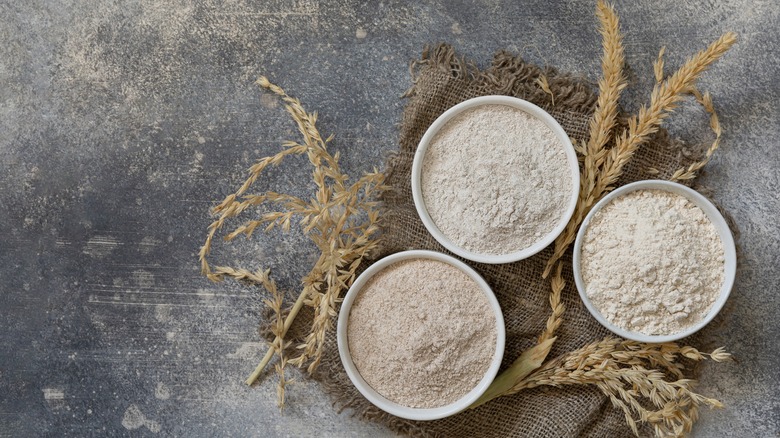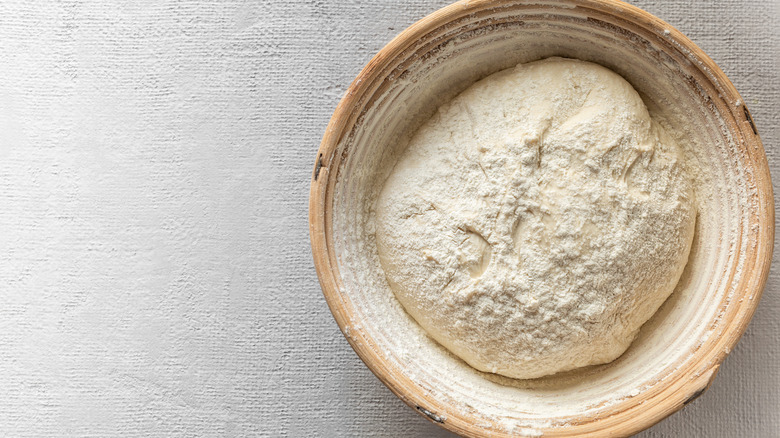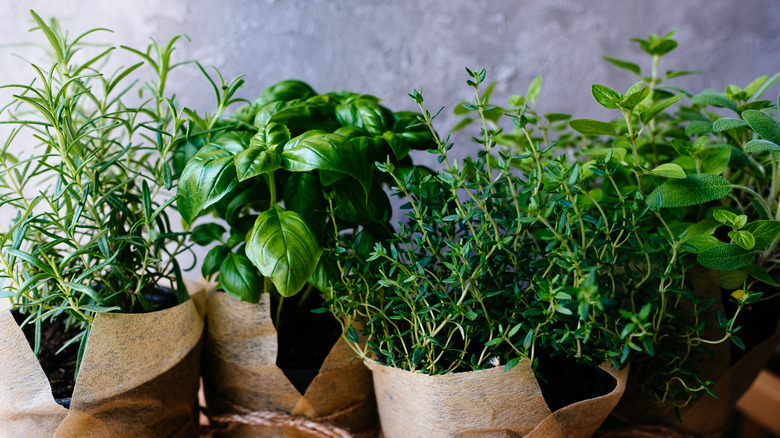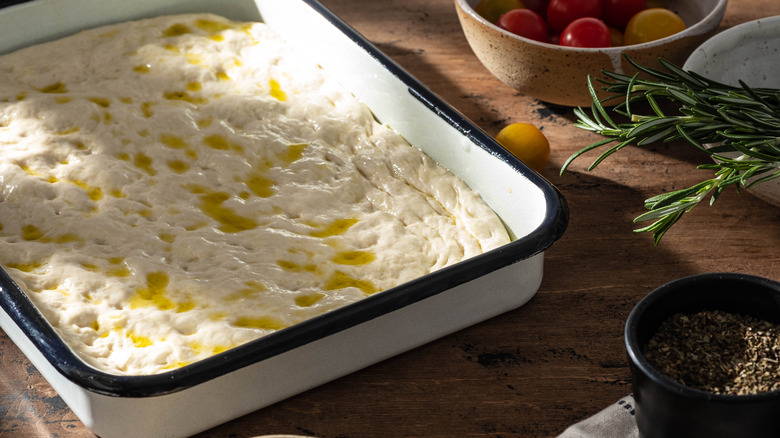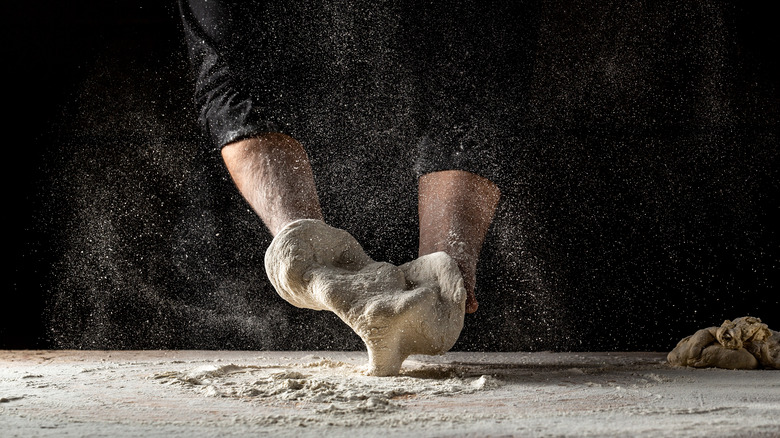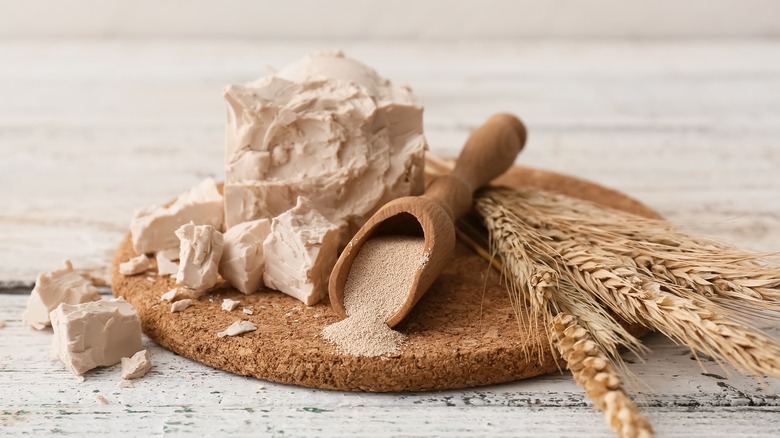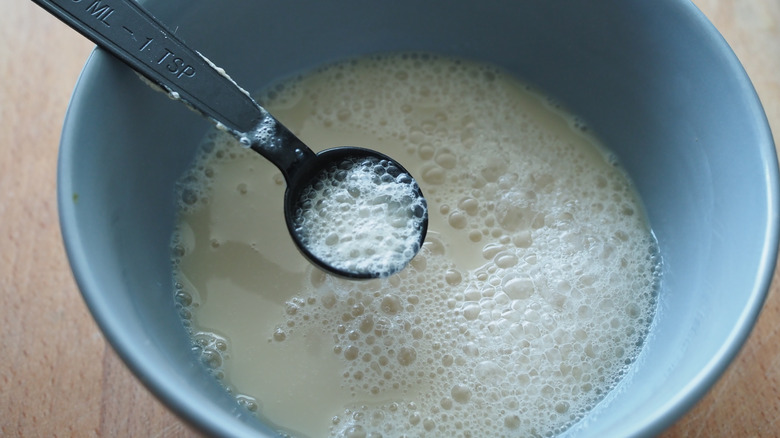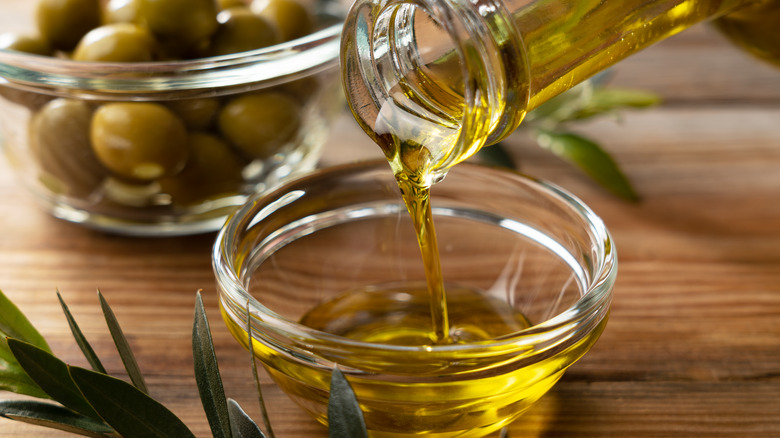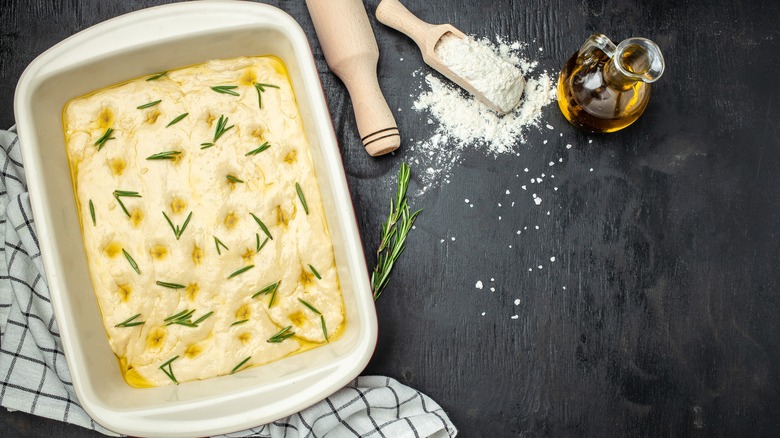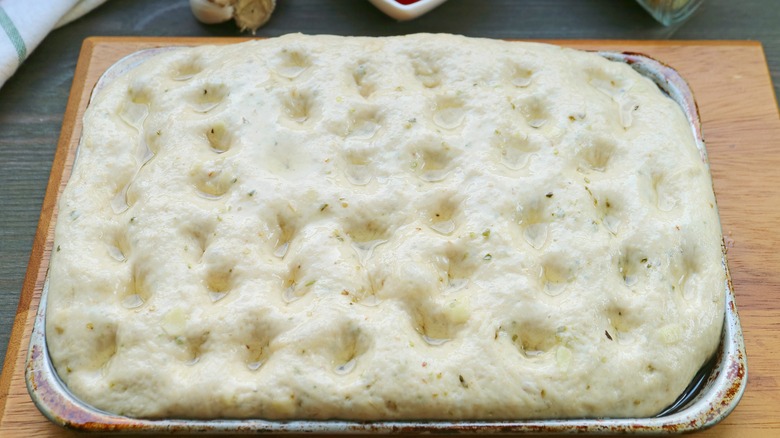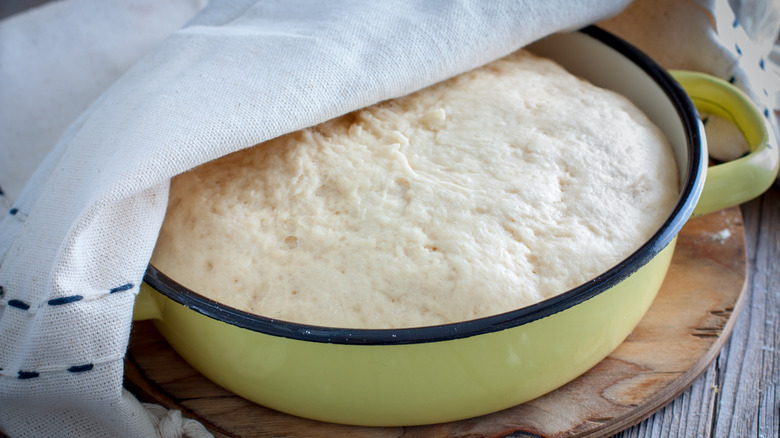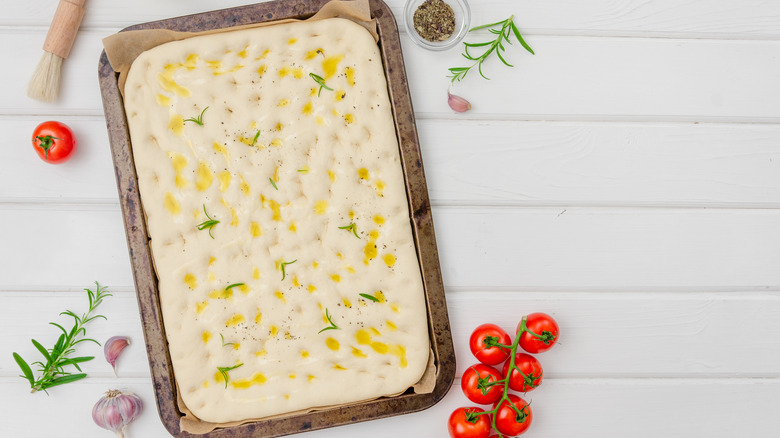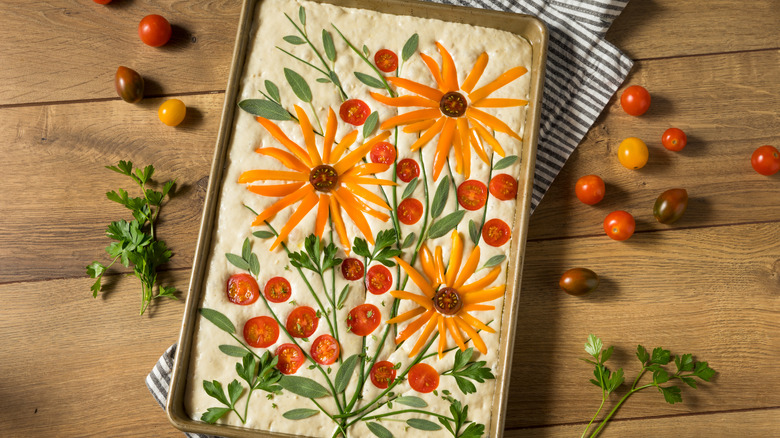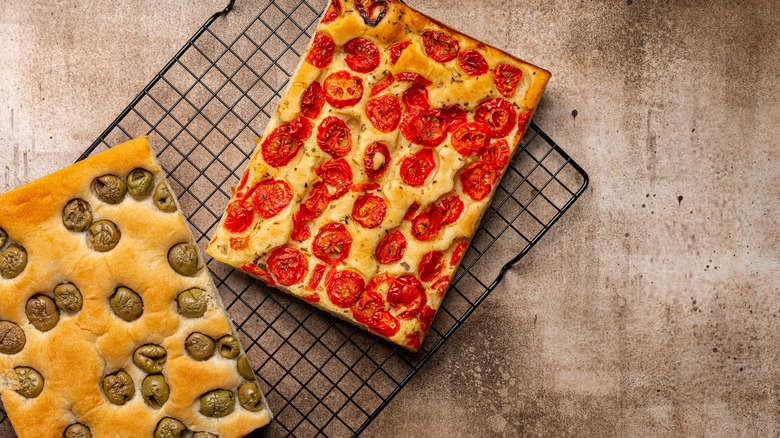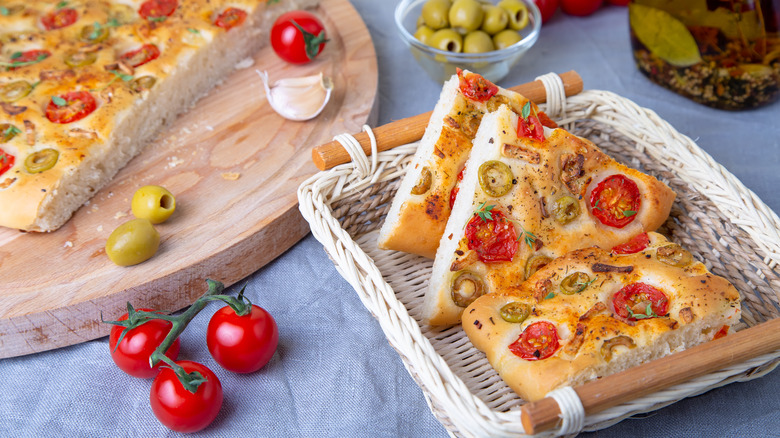15 Crucial Tips For Baking The Best Focaccia
We may receive a commission on purchases made from links.
Italian focaccia is a type of bread made with leavened dough, characterized by a crunchy crust on the bottom and an oily top. Classic focaccia, or Ligurian focaccia, is a simple bread made with flour, water, olive oil, and salt. It may have herbs like rosemary or oregano, but for the most part, it relies on olive oil and salt for the texture and flavor.
Focaccia, thought to be the precursor to modern-day pizza, has been around since the time of the Ancient Greeks (via Tuscookany). The name comes from the way the bread was cooked on the coals. But this simple bread that started as a food for the peasants has transformed into a popular inexpensive snack or meal.
There are many versions of it throughout Italy, from focaccia with creamy cheese to focaccia with a layer of salty anchovies to stuffed focaccia with pieces of smoky pork. It went from savory to sweet in Venice, with the thick bread covered in sugar and cinnamon and sometimes sprinkled with nuts and raisins. Really, focaccia can be a lot of things, which is why it's a great choice for novice bread makers to hone their skills and flex their creativity. If you are new to baking, here are some crucial tips for baking the best focaccia.
Use the right flour
It all starts with flour. Using the correct type of flour makes all the difference when making focaccia. While you are probably familiar with all-purpose flour as the go-to standard used in many baked goods, from muffins to cakes, bread flour is the best choice for focaccia.
Bread flour is a type of flour used for making yeasted doughs like bread dough and pizza dough. Bread flour is ideal because it has more protein than all-purpose flour, which means it has more gluten. This translates to a stretchier dough that allows the bread to rise (via WebstaurantStore). The stretchier dough is easier to work with and, most importantly, yields a lighter, airier finished product. So to get the best possible focaccia, you will need to swap out all-purpose flour for bread flour. Of course, if all you have on hand is all-purpose flour, you can still make your focaccia with it. It just will be denser and lack the signature focaccia crust.
Don't let the dough get too dry
Focaccia dough is a high-hydration dough, meaning it is a sticky, wet dough. Hydration in dough refers to the ratio of water to flour. For example, if the dough has 1 cup of water to 1 cup of flour, then the hydration is 100%. A dough with 1,000 grams of flour and 600 grams of water has 60% hydration. Hydration is always calculated by weight (via The Bread Maiden). Low-hydration doughs, around 50% to 57%, are used to make bagels and pretzels, while high-hydration doughs, 65% to 80%, are preferred for pizza dough and focaccia. Ciabatta bread is one of the highest-hydration doughs at around 90%, giving it a light, airy texture.
Keeping your dough hydrated is the key to getting the right texture in your focaccia. If your dough doesn't have enough water, it can dry out, affecting the focaccia's structure. Of course, working with a high-hydration dough takes a little practice because it's sticky, but it is worth it because, with bread like focaccia, the texture is key.
Spice your dough
While most focaccia recipes add fresh herbs like rosemary, oregano, or thyme right before the dough goes in the oven, you can give your bread more flavor by adding the herbs and spices directly to the dough. The benefit of doing so is that the herbs infuse the mixture and make for a more aromatic dough and subsequently bread.
Rosemary is usually the go-to herb on focaccia because it has a robust and intense aroma that pairs well with other flavors, but it is by no means the only option to choose from. When selecting your flavors, think of the focaccia as a blank canvas and use a variety of complementary herbs. Try tarragon, marjoram, basil, or even a hint of spice with red pepper flakes. Focaccia is all about the texture, but the flavor profile has more wiggle room for creativity. Adding herbs straight to the dough ensures you will have flavorful focaccia in each and every bite.
Bake in the right pan
Focaccia, like pizza, must be baked in a very hot oven to get the ultimate crust. But the pan you choose to bake your bread in can change the crust's texture, taking it from chewy to crispy. You should consider your favorite type of focaccia crust when deciding which pan to use. Many home chefs bake focaccia in a 9 x 13 glass Pyrex baking dish. This provides a spongy crust with a light crumb. You can also bake focaccia in a cast iron pan, giving the crust a crispier, crunchier outside while leaving the center soft and chewy. A baking sheet or stone creates a thinner focaccia with a crispier crust.
The right type of pan is the one that makes focaccia the way you like it. Regardless of which dish you use, make sure to use plenty of oil to keep the focaccia from sticking to the bottom.
Take care of your dough
It is important to take care of your dough whenever making yeasted bread, and focaccia is no exception. When making focaccia dough, combining the ingredients is not enough; it's essential to combine them in the correct order. Since the dough has only four ingredients — flour, water, yeast, and salt — it seems easy. Just throw it together and mix. But it's more nuanced than that. You can start by mixing the water and flour and then mix the activated yeast, waiting to include the salt last. Too much salt can kill yeast, so you want to disperse the activated yeast in the dough before you add the all-important salt.
Salt is essential to a good yeast dough, whether it's for bread, pizza, or focaccia. King Arthur Baking Company explains that salt is responsible for four key things: the flavor, the gluten structure, the fermentation, and the color of the crust. So don't skip the salt.
Properly caring for your dough also means kneading it well but not over-kneading it. Over-kneading can lead to tough, dense bread and is mainly a concern for those who use a mixer. If you are kneading your dough by hand, you should look for the telltale signs that it's finished, such as springing back when you poke it or feeling tacky rather than sticky.
Know your yeast
Yeast is a living organism that is responsible for the fermentation process in bread making. There are different types of yeast available, and it's important to know which is best for your recipe. Active dry yeast is the most common type of yeast and is used in focaccia, pizza dough, and other bread. It is sold in little packets and has a long shelf life. Active dry yeast must be activated before adding it to your dough.
Instant active yeast, sometimes called rapid-rise yeast, doesn't need to be activated, so you can pour it directly into your dough, and it has a faster rise time. This yeast is popular with home bakers making bread in a bread machine (via Bread Machine Pros). Lastly, cake yeast is sold in concentrated wet bricks and is less common to use at home because it has a short shelf life and is more challenging to use. However, you may find it in commercial kitchens as it is preferred among professional bakers.
Don't kill your yeast
Ok, so you have the right yeast for your focaccia — active dry yeast. Now it's time to activate it. Bob's Red Mill explains that all you need to do is add warm water between 105 and 115°F and a pinch of sugar to activate your yeast. Set it aside for 10 minutes, and when it starts bubbling, it's ready to use. If it doesn't start bubbling, then the yeast is dead. This could be because the yeast had expired or the water was too hot.
If your yeast is dead, throw it out and start again. If you bake focaccia or other yeasted bread regularly, then it's a good idea to keep an eye on the expiration dates of your packets to avoid keeping expired yeast. Packs have a shelf life of two years if stored in a cool, dry place like your pantry, refrigerator, or freezer (via Market Basket).
Use good oil
Focaccia bread is an oily bread, but not just any oil will do. The best oil for focaccia is olive oil. The first time you make focaccia at home, you may be surprised at just how much olive oil you will use. It goes on the bottom of the pan and on top of the dough, which seems like a lot. But it is necessary because the oil helps give the bread its texture and flavor. Other options like vegetable, soybean, or canola oil will make focaccia oily but won't contribute to the flavor profile. Extra virgin olive oil is preferred, but regular olive oil is fine too.
Luckily you don't have to worry about using so much olive oil in your focaccia because it has plenty of health benefits. According to Healthline, olive oil contains antioxidants, helps protect against heart disease, has anti-inflammatory properties, and isn't connected to weight gain. So enjoy your olive oily focaccia.
Generously oil the pan
Every home chef knows the importance of greasing the bottom of the pan. It only takes one batch of brownies, cake, pizza, or focaccia sticking to the bottom to learn that lesson. And in the case of focaccia, oiling the pan is about more than just keeping it from sticking; it is about infusing the crust with flavor and getting the right texture.
One common mistake home chefs make when learning the ins and outs of focaccia is not oiling the pan enough. It may be surprising to see the dough nestled in a thick layer of oil, but that's the key to getting the perfect spongy yet crunchy, chewy crust. The pan should have anywhere from 1/8 to 1/4 inch of oil (via Chicago Tribune). So if you are having difficulty getting your focaccia crust to the right texture, ensure you are oiling the pan enough.
Don't forget to dimple the dough
If you are having trouble getting your focaccia to come out of the oven with the right amount of moisture and instead have a dry, tasteless loaf, it might be because you didn't dimple the dough. In the world of focaccia, to dimple the dough means to use your fingers to push into the dough and create little holes. Be careful not to poke holes all the way through. Instead, create little indents on top of the surface.
These little focaccia dimples are not just for looks, although they are the characteristic of good focaccia. Thyme & Envy explains that dimpling the dough allows it to rise slowly and keeps the air bubbles in the dough from bursting during the cooking process, which would flatten the entire focaccia and make it too dense. Another reason the surface is dented is so the dimples can hold the olive oil while the dough bakes, giving the focaccia its golden color.
Let it rise
It is no secret that yeasted dough needs time to rest and rise. If your focaccia dough doesn't get enough time to do so, it won't have that airy look and chewy texture that distinguishes it from other bread. It's easy to get impatient and want to make your loaf faster, but bread-making rewards patience, so make sure you allow enough time for resting and rising.
Focaccia dough, like most yeasted doughs, needs to rise twice. Knead Rise Bake explains that the second rise gives the yeast more time to do its magic and makes for airy bread with a more complex flavor. Only letting the dough rise once creates a dense bread without the light crumb. With focaccia, the first rise is in a bowl, and the second is in a pan with dimpled dough.
Another thing to consider when the dough is resting and rising is the temperature of your kitchen. King Arthur Baking Company states that the ideal temperature for dough to rise is between 75 to 78°F. Depending on where you live, you might need to make some adjustments to ensure your kitchen is not too cold or too warm to get your focaccia dough to rise.
Brine the top of your focaccia
Brining is usually associated with proteins like chicken, fish, and of course, Thanksgiving turkey. But brining is also an important step in making focaccia. Brining is basically adding salted water to food to infuse flavor and moisture. According to Exploratorium, the ratio for a basic brine is 1 tablespoon of salt per 1 cup of water.
Salt Fat Acid Heat writer Samin Norsat suggests brining the focaccia dough after dimpling it but before the second rise. The salty brine will fill the dimples and keep the bread from drying. After the second rise with the brine, it is time to bake the focaccia. When it comes out of the oven, you will want to liberally brush olive oil over the bread and let it sit and soak before serving. Brining the dough before baking ensures you have the right flavor, texture, and moisture.
Get artistic with toppings
Focaccia is the perfect edible canvas. If you want to make delicious focaccia that makes a statement, get creative and make your loaf into a work of art. The list of bread toppings is never-ending. So many herbs, vegetables, and cheeses can be added to focaccia, so utilize those colorful toppings to create an eye-catching design.
Use red onions, red and yellow peppers, and bright cherry tomatoes to make colorful flower petals. Green parsley or chives are perfect for flower stems, and black or green olives are excellent choices for the center of the flowers. Yellow tomatoes make a bright sun or stars. Capers add a salty taste, and blue cheese adds a textured hue. There really is no limit to all of the ways you can decorate your focaccia. Many say bread making is an art form, so get creative with your edible canvas and make your focaccia memorable with colorful and tasty toppings arranged into a masterpiece.
Use a cooling rack
You followed all the tips, and your focaccia came out perfect, but you are not entirely done yet. One more key step to ensuring you have the best focaccia is to take it out of the oily pan after it's done baking and let it cool on a cooling rack. Doing so keeps the bottom from becoming too wet or soggy. Air needs to circulate around the bread for it to cool properly.
Different types of bread need different amounts of cooling time. For focaccia, 45 minutes to cool is ideal (via Busby's Bakery School). When bread cools, the outside cools faster, and the moisture inside exits as vapor. Bread that hasn't adequately cooled can be gummy because there is still too much moisture. It's tough to be patient, but your focaccia will look and taste better if it is properly cooled. If you bake bread regularly, then you should have a cooling rack. But if you don't, you can always improvise with a rack from your oven lifted on each side so air can flow around the bread.
Give your focaccia a long life
Keep your focaccia from drying out and becoming stale by storing it right. You don't want to go to the trouble of making the perfect loaf and then have it get hard and stale from not being stored properly. The way you store your focaccia depends on what toppings you have added. If you have added cheese, meats, or perishables, then you should store it in an airtight container in the refrigerator, where it will last for several days. If your focaccia is plain with just herbs and salt, you can store it wrapped in plastic and a storage bag or airtight container on the counter at room temperature for a couple of days (via Masterclass).
If you aren't eating your focaccia right away, you can freeze it. The best way to do so is to cut it into servings and freeze them on a baking sheet. When the pieces are frozen, wrap them individually in plastic wrap and place them in a freezer-safe bag for up to one month.
